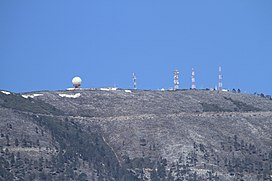Cerro Potosí
| Cerro El Potosí | |
|---|---|
 Cerro Potosí in the end of winter, viewed from Pozo del Gavilán. | |
| Highest point | |
| Elevation | 3,721 m (12,208 ft)[1] |
| Prominence | 1,876 m (6,155 ft)[1] |
| Listing | |
| Coordinates | 24°52′18″N 100°13′57″W / 24.87167°N 100.23250°W[1] |
| Geography | |
| Location | Galeana, Nuevo León, Mexico |
| Parent range | Sierra Madre Oriental |
| Climbing | |
| Easiest route | road |

Cerro El Potosí is the highest mountain in the Sierra Madre Oriental mountain range of northeast Mexico. It is located in the state of Nuevo León, about 80 km (50 mi) south of Monterrey.[2]
Flora and fauna[edit]
It is composed of limestone, and is noted for its very diverse flora including several endemic or near-endemic species, such as the Potosi Pinyon. At the foot of the mountain, a series of springs and endorheic basins were the only site in which the pupfish Cyprinodon alvarezi and Megupsilon aporus, and the dwarf crayfish Cambarellus alvarezi lived. The last two are entirely extinct, while Cyprinodon alvarezi is extinct in the wild (only survives in captivity).[3][4][5]
Access[edit]
Access was very difficult in the past, but in the 1960s a microwave relay station was built on the summit, with the road built for this providing easy access from the east.
Protected areas[edit]
In 2000 the upper slopes of the mountain were designated an ecological reserve, covering 9.02 km2.[6] A northern portion of the mountain, including the actual summit, are in the Cuenca Alimentadora del Distrito Nacional de Riego 026 Bajo Río San Juan, a natural resources protection area.
See also[edit]
References[edit]
- ^ a b c "Mexico Ultras" See footnote 14. Peaklist.org. Retrieved 2012-10-18.
- ^ "Cerro el Potosí - Peakbagger.com". www.peakbagger.com. Retrieved 2018-07-17.
- ^ Ceballos, G.; E.D. Pardo; L.M. Estévez; H.E. Pérez, eds. (2016). Los peces dulceacuícolas de México en peligro de extinción. pp. 72–74, 78–79. ISBN 978-607-16-4087-1.
- ^ Valdes Gonzales, A. (2019). "Cyprinodon alvarezi". IUCN Red List of Threatened Species. 2019: e.T6144A3104750. doi:10.2305/IUCN.UK.2019-2.RLTS.T6144A3104750.en. Retrieved 12 November 2021.
- ^ Alvarez, F.; López-Mejía, M.; Pedraza Lara, C. (2010). "Cambarellus alvarezi". IUCN Red List of Threatened Species. 2010: e.T153825A4550209. doi:10.2305/IUCN.UK.2010-3.RLTS.T153825A4550209.en. Retrieved 12 November 2021.
- ^ UNEP-WCMC (2021). Protected Area Profile for Cerro El Potosí from the World Database of Protected Areas. Accessed 7 September 2021. [1]
External links[edit]

